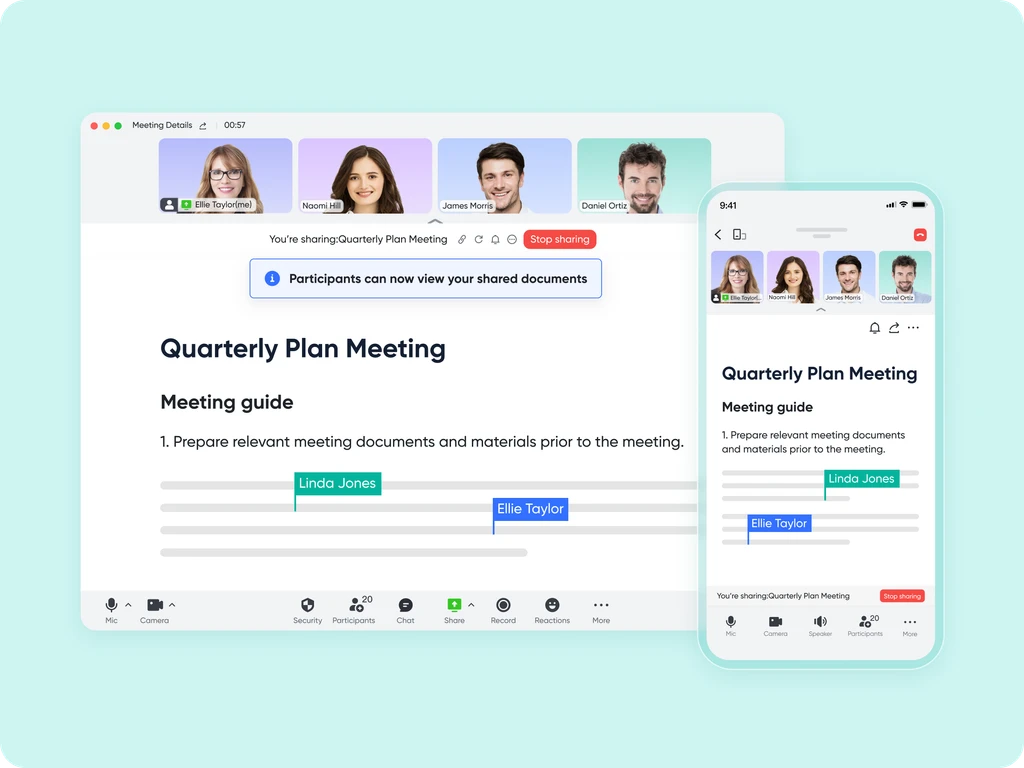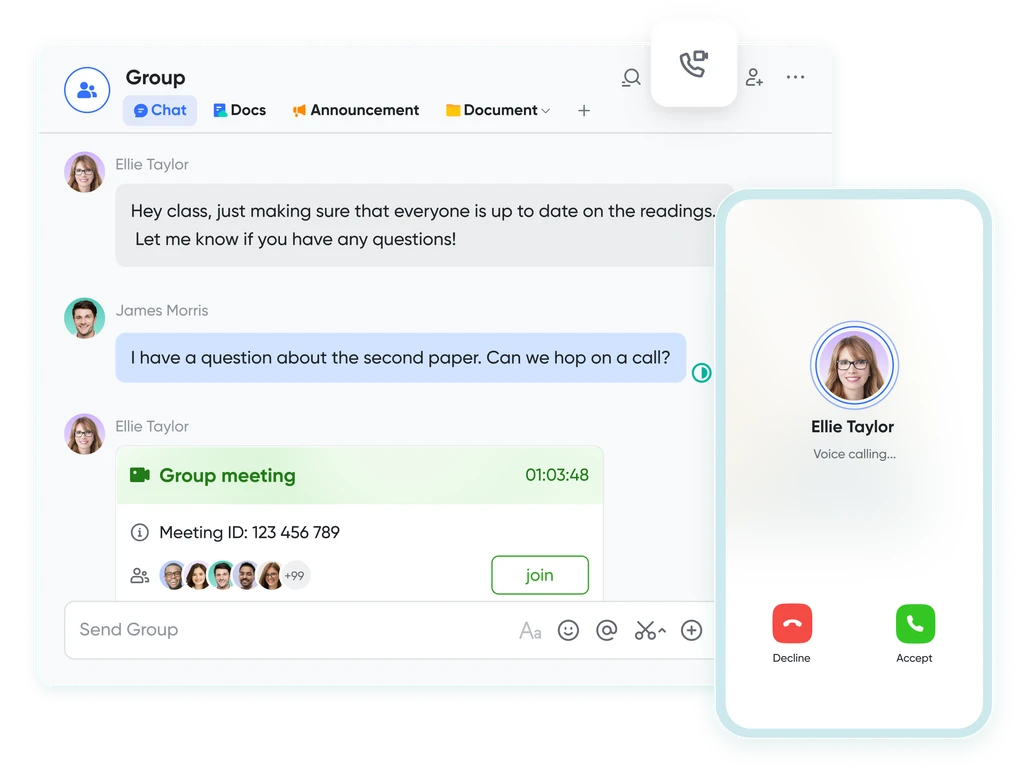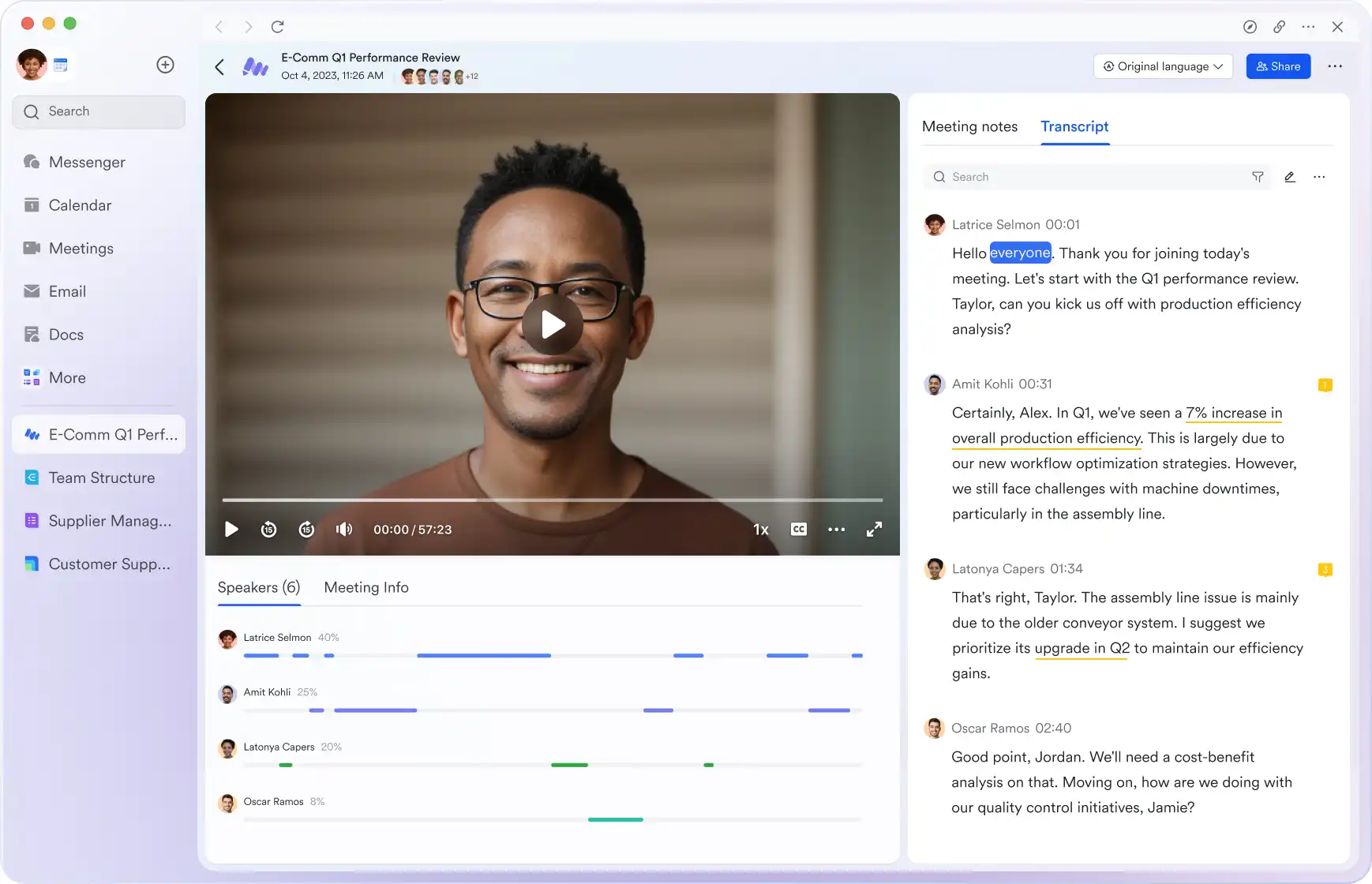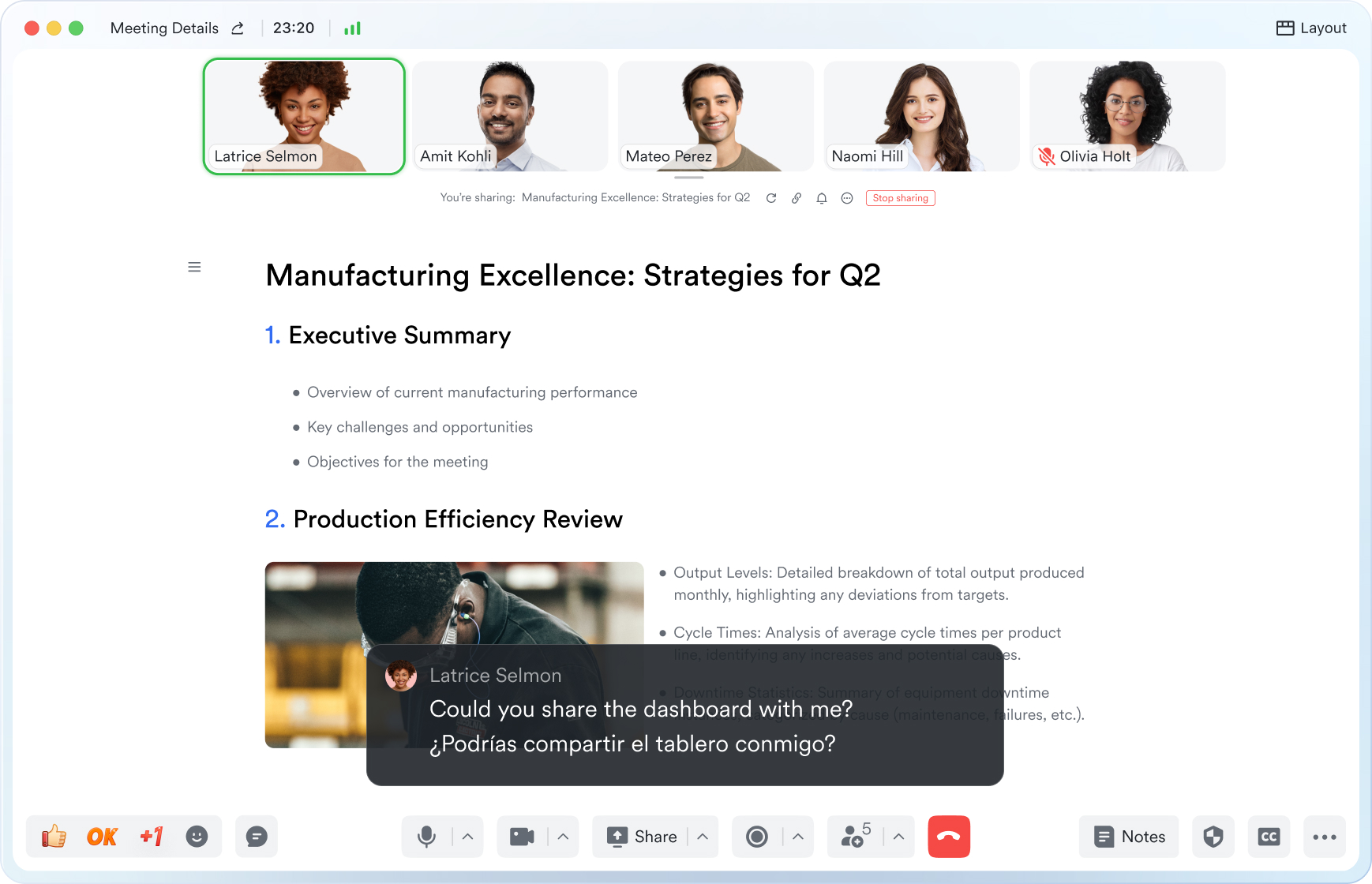Strategy Meeting
This guide will walk you through the essential elements of use strategy meeting to keep your attendees aligned and engaged.
Try Lark for Free
In the constantly evolving business world, the significance of successful strategy meetings cannot be overstated. As we step into 2024, the dynamics of hosting strategy meetings have undergone significant changes, and it is crucial to adapt to these transformations. Whether you are a seasoned professional or an aspiring leader, this comprehensive guide is designed to equip you with the essential knowledge to conduct remarkable strategy meetings and steer your organization toward success in 2024.
Use Lark Meetings to turn meetings into true collaborative experiences.
What is a strategy meeting?
A strategy meeting is a dedicated gathering where key stakeholders convene to deliberate on essential organizational pursuits and devise comprehensive plans to achieve them. It serves as a platform for aligning perspectives, setting strategic targets, and generating actionable insights to fortify the organization's direction. Over time, these meetings have evolved to become instrumental in ensuring cohesive and forward-thinking decision-making processes. In today's dynamic business landscape, the essence of strategy meetings lies in their ability to unify the vision of the organization and drive coordinated, purpose-driven actions.
Goals of strategy meeting
Clarifying Organizational Objectives
The primary goal of a strategy meeting is to provide a clear delineation of the organizational objectives. This involves imparting a comprehensive understanding of the long-term vision and the strategic milestones that need to be achieved to realize it. Through collaborative discussions and critical analysis, the meeting should serve as a platform to forge a unified understanding of the organization's goals and aspirations.
Encouraging Collaborative Decision-Making
Another pivotal goal of a strategy meeting is to foster an environment conducive to collaborative decision-making. It aims to draw upon the collective expertise and insights of the diverse set of participants, leveraging their varied perspectives to devise effective strategies and action plans. By encouraging open dialogues and idea exchanges, the meeting endeavors to harness the collective intelligence of the attendees, thereby culminating in well-grounded decisions.
Crafting Actionable Plans for Execution
Finally, the strategy meeting is geared towards the formulation of actionable plans for execution. It endeavors to translate the conceptual strategies and overarching goals into tangible action items with well-defined deliverables, timelines, and accountability matrices. Through meticulous planning and strategic allocation of resources, the meeting endeavors to chart a clear roadmap for successful execution.
Who should attend strategy meeting?
The attendance at a strategy meeting should represent a comprehensive cross-section of the organizational hierarchy and relevant stakeholders, aiming to diverse perspectives and expertise to the table.
-
Key Stakeholders and Decision-Makers: It is imperative to ensure the participation of senior leadership, including C-suite executives and senior management figures, who hold substantial decision-making authority and overall strategic accountability.
-
Involvement of Departmental Representatives: Apart from the leadership cadre, the inclusion of select departmental heads and functional managers is pivotal. This not only encapsulates their expertise but also ensures that the strategies are aligned with the functional goals and operational nuances of the respective units.
-
Role-based Inclusions for Effective Contributions: The attendance should extend to personnel with roles and functions critical to the strategic domains under discussion. This could encompass individuals from marketing, finance, operations, and other relevant segments as per the agenda of the meeting.
Ensuring a well-represented and diverse group of attendees is crucial to garner multifaceted insights and perspectives, which are indispensable in the formulation of holistic strategies.
Related:
Unlock the Power of Webinars: A Comprehensive Guide to Boost Your Business | Lark Blog | Lark BlogLearn more about Lark x Meetings
Topics, agenda, and structure of strategy meeting
Identifying Relevant Discussion Topics
The heart of a successful strategy meeting lies in the formulation of a well-thought-out agenda that reflects the pertinent topics for discussion. These topics could encompass a wide array of subjects such as market analysis, competitive positioning, resource allocation, innovation strategies, and risk management, among others. The agenda should be tailored to mirror the long-term objectives and immediate challenges faced by the organization, thus warranting a comprehensive deliberation.
Crafting a Comprehensive Agenda
A meticulously crafted agenda is pivotal to the structure of a strategy meeting. It outlines the topics, time allocations, and the ceremony for each session, thereby providing a defined roadmap for the meeting proceedings. The agenda should consciously balance the need for in-depth discussions with the necessity to cover a broad spectrum of subjects, fostering a well-rounded approach to the strategic deliberations.
Structuring the Meeting for Optimal Engagement
The structural framework of the meeting plays a critical role in ensuring optimal participation and engagement. It is essential to intersperse the sessions with interactive elements, including brainstorming sessions, breakout discussions, and presentation segments. This variety helps in sustaining the participants' interest and ensures the effective assimilation of diverse perspectives, ultimately enriching the quality of the discussions.
Learn more about Lark x Meetings
How often does a strategy meeting occur?
The frequency of strategy meetings is contingent on the organizational context, taking into account the nature of the industry, the organization's growth phase, and the immediacy of strategic realignments.
-
Frequency Considerations Based on Organizational Needs: In dynamic and rapidly evolving sectors, frequent strategy meetings may be imperative to respond swiftly to market shifts and capitalize on emerging opportunities.
-
Adaptability to Industry Shifts and Time Sensitivity: The frequency also needs to adapt to industry fluxes, such as regulatory changes, technological disruptions, and competitive landscapes that necessitate timely strategic recalibration.
-
Balancing Regularity and Strategic Fluidity: While a regular cadence of meetings fosters strategic constancy, it is crucial to maintain fluidity, allowing for impromptu gatherings when critical strategic imperatives dictate an immediate convergence of minds.
Ultimately, the frequency of strategy meetings should strike a balance between maintaining strategic steadfastness and accommodating adaptability to the evolving business ecosystem.
Key difference between strategy meeting and another similar meeting
Distinguishing Strategy Meeting from Operational Meetings
While strategy meetings are geared towards setting the overall course and identifying long-term objectives, operational meetings primarily dwell on the ongoing, day-to-day activities and the tactical implementation of predefined strategies.
Contrasting Strategy Discussions with Tactical Decision-Making Sessions
Strategy meetings entail in-depth, long-range deliberations that focus on navigating the organization's future trajectory, in contrast to tactical meetings that deal with the immediate actions and problem-solving necessitated by existing operational challenges.
Aligning the Objectives and Focus Areas of Different Meetings
While both strategy and operational meetings are pivotal for the organization, the former steers the broad strategic course, whereas operational meetings essentially lay out the roadmap for executing the formulated strategies.
Related:
Unlock the Power of Webinars: A Comprehensive Guide to Boost Your Business | Lark Blog | Lark BlogLearn more about Lark x Meetings
Three practical examples of strategy meeting
Example 1: initiating market expansion strategy meeting
Example 1: initiating market expansion strategy meeting
Objective: The objective of this meeting is to strategize the organization's expansion into new markets, encompassing meticulous market assessments, competitor analyses, and the formulation of comprehensive market entry strategies.
Participants: Chief Executive Officer (CEO), Chief Marketing Officer (CMO), Head of Business Development, Market Research Analysts.
Key Agenda:
-
Market Research Findings and Analysis
-
Key Competitor Profiles and SWOT Analysis
-
Formulating Market Penetration Strategies
Outcome: A comprehensive market expansion blueprint outlining the target geographies, market entry tactics, and resource allocation strategies.
Example 2: restructuring organizational dynamics strategy meeting
Example 2: restructuring organizational dynamics strategy meeting
Objective: This meeting aims to deliberate on restructuring the organizational dynamics to align with emerging industry trends, embracing digital transformation, and fostering operational agility.
Participants: Chief Operations Officer (COO), Human Resource Director, Chief Information Officer (CIO), Departmental Heads.
Key Agenda:
-
Embracing Technological Advancements
-
Redefining Hierarchical Structures
-
Fostering a Culture of Innovation and Adaptability
Outcome: A restructured organizational blueprint encompassing technological integration, organizational redefinition, and talent reskilling initiatives.
Example 3: crisis management and recovery strategy meeting
Example 3: crisis management and recovery strategy meeting
Objective: The focus of this meeting is to formulate crisis management strategies and recovery blueprints to navigate through market adversities, economic downturns, or global pandemics.
Participants: Chief Financial Officer (CFO), Legal Counsel, Risk Management Specialists, Public Relations Officer (PRO).
Key Agenda:
-
Crisis Scenario Planning
-
Financial Risk Mitigation Strategies
-
Stakeholder Communications and Restoration Plans
Outcome: A crisis management protocol and a recovery roadmap inclusive of financial mitigation strategies, communication plans, and reputation restoration initiatives.
Common pitfalls of a strategy meeting
-
Misalignment of Meeting Objectives and Outcomes: One of the common pitfalls is deviating from the intended meeting objectives, resulting in superficial discussions and a lack of tangible strategic outcomes.
-
Inadequate Preparation and Planning: Insufficient pre-meeting preparations and a lack of a comprehensive agenda often lead to time inefficiencies and inconclusive deliberations during the meeting.
-
Lack of Tangible Action Points and Follow-up Mechanisms: Failing to derive actionable strategies and neglecting robust follow-up mechanisms for tracking the executed plans to fruition can render the meeting futile.
Learn more about Lark x Meetings
Dos and don't s of a strategy meeting
| Dos | Don't s |
|---|---|
| Clearly articulate the meeting objectives. | Engage in inconclusive discussions. |
| Promote active participation and idea exchanges. | Neglect to leverage diverse perspectives. |
| Ensure a well-structured and inclusive agenda. | Deviate from the outlined meeting agenda. |
| Establish actionable outcomes and accountability. | Overlook post-meeting follow-up mechanisms. |
Conclusion
In conclusion, the success of a strategy meeting is contingent upon meticulous planning, comprehensive participation, and a relentless focus on generating tangible outcomes. As we stand on the brink of 2024, it is imperative for organizations and business leaders to imbibe agility, resilience, and foresight in conducting strategy meetings. By adhering to the principles elucidated in this guide, organizations can pave the way for strategic alignment, cohesive decision-making, and sustainable growth, enhancing their competitive positioning in the rapid and dynamic contemporary business landscape.
Related:
Master the Art of Meeting Notes with Lark for Enhanced Collaboration | Lark Blog | Lark BlogLearn more about Lark x Meetings
Use Lark Meetings to turn meetings into true collaborative experiences.
A Game Changer for Strategy Meeting: Empower your team with Lark Meetings
In the fast-paced and dynamic world of modern business, effective communication and collaboration are crucial for success of Strategy Meeting. Here we introduce Lark Meetings to serve as a centralized hub for all communication needs.
Transform your meetings into collaborative endeavors

Leverage the potency of in-call document sharing, intelligent meeting minutes, and mobile-optimized features to enhance productivity collaboratively, irrespective of your location or schedule.
Seamlessly collaborate in real-time, across any device

Share live documents instead of just screen views. Participants can navigate and edit simultaneously within the video call window, even while on the move.
Shift your focus to engagement, not note-taking

Lark Minutes automatically converts video meetings into transcripts, facilitating easy viewing, searching, and collaborative editing. Stay in the loop asynchronously, even if you can't attend the live meeting. Lark Minutes for meeting minutes support translation into 10+ different languages.
Break language barriers in communication

Lark Meetings provide real-time translation for subtitles, allowing individuals from diverse backgrounds to express themselves in their native languages. Ensure every voice is heard, regardless of geographical location. Live subtitles currently support translations from English, Chinese, and Japanese to 10+ different languages. See more translation feature in Lark.
Connect with larger audiences
Host dynamic online meetings and events accommodating up to 1,000 participants, with the flexibility of up to 50 breakout sessions for intimate group discussions within the larger meeting context. Try more Lark features for free.








